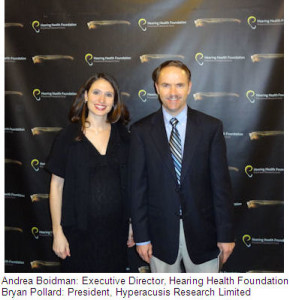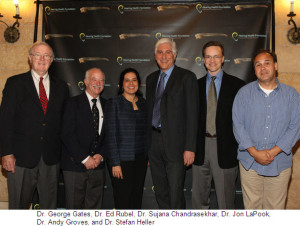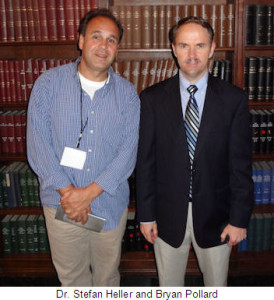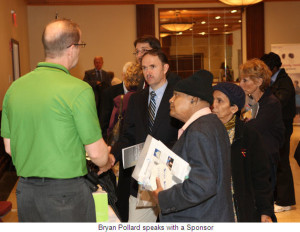“The Promise of Cell Regeneration”
 On October 3, 2011, Bryan Pollard represented Hyperacusis Research at the Summit on Hearing Restoration at the New York Academy of Medicine. This Summit was sponsored by the Hearing Health Foundation. It brought together the leaders in the field of cell regeneration research to discuss what needs to be accomplished for therapy for cell regeneration in the ear to become a reality. Learn more about Hearing Health Foundation’s ground-breaking Hearing Restoration Project. While this Summit did not relate directly to issues with Hyperacusis, the Hearing Restoration Project is an important effort because hair cell damage is still a possible consideration in the etiology of Hyperacusis. Also Hyperacusis Research has formed a strong partnership with the Hearing Health Foundation to fund research projects.
On October 3, 2011, Bryan Pollard represented Hyperacusis Research at the Summit on Hearing Restoration at the New York Academy of Medicine. This Summit was sponsored by the Hearing Health Foundation. It brought together the leaders in the field of cell regeneration research to discuss what needs to be accomplished for therapy for cell regeneration in the ear to become a reality. Learn more about Hearing Health Foundation’s ground-breaking Hearing Restoration Project. While this Summit did not relate directly to issues with Hyperacusis, the Hearing Restoration Project is an important effort because hair cell damage is still a possible consideration in the etiology of Hyperacusis. Also Hyperacusis Research has formed a strong partnership with the Hearing Health Foundation to fund research projects.
Panel Discussion
 The event started out with a panel discussion lead by Dr. Jon Lapook of the CBS Evening News. The members of the panel were: Dr. Sujana Chandrasekhar from New York Otology, Dr. Ed Rubel from the University of Washington, Dr. Stefan Heller from Stanford University and Dr. Andy Groves from Baylor College of Medicine. An interesting perspective from the panel discussion was how much less the NIH funds hearing research compared to cancer and other significant health issues. That was an important insight into possibly why it is even more difficult to get funding for hyperacusis since it represents only a fraction of the population with ear issues. Dr. Lopook referenced a recent news story highlighting the growing risk of hearing loss for children. There was a good question about why there were not more news stories on hearing challenges. Dr. Lopook described the significant challenge of getting even one deeper story of 5 or 6 minutes into the evening news every few weeks. Dr. Chandrasekhar gave a good overview the basic clinical types of cases she works with. She supports efforts with veterans who have hearing damage from the battle field. Dr. Rubel described the historical work that was accomplished to discover that birds and reptiles re-grow hair cells after damage. This gives a great model to study to understand why mammals are different since no mammal can re-grow hair cells after damage. Dr Heller gave a short description of how various types of stem cells can be used as a basis to initiate new hair cell growth. Finally Dr. Groves described briefly how hair cells grow. Each of these researchers gave a much more detailed description in their presentation.
The event started out with a panel discussion lead by Dr. Jon Lapook of the CBS Evening News. The members of the panel were: Dr. Sujana Chandrasekhar from New York Otology, Dr. Ed Rubel from the University of Washington, Dr. Stefan Heller from Stanford University and Dr. Andy Groves from Baylor College of Medicine. An interesting perspective from the panel discussion was how much less the NIH funds hearing research compared to cancer and other significant health issues. That was an important insight into possibly why it is even more difficult to get funding for hyperacusis since it represents only a fraction of the population with ear issues. Dr. Lopook referenced a recent news story highlighting the growing risk of hearing loss for children. There was a good question about why there were not more news stories on hearing challenges. Dr. Lopook described the significant challenge of getting even one deeper story of 5 or 6 minutes into the evening news every few weeks. Dr. Chandrasekhar gave a good overview the basic clinical types of cases she works with. She supports efforts with veterans who have hearing damage from the battle field. Dr. Rubel described the historical work that was accomplished to discover that birds and reptiles re-grow hair cells after damage. This gives a great model to study to understand why mammals are different since no mammal can re-grow hair cells after damage. Dr Heller gave a short description of how various types of stem cells can be used as a basis to initiate new hair cell growth. Finally Dr. Groves described briefly how hair cells grow. Each of these researchers gave a much more detailed description in their presentation.
How We Hear
The first speaker was Dr. George Gates who is on the board of the Hearing Health Foundation. His presentation gave a good overview of the basic ear function including the inner ear and hair cell function. He described how the outer hair cells (OHC) work from feedback signals to amplify quiet sounds. Responding to a question Bryan Pollard asked about what other function the OHC has for the auditory system, Dr. Gates responded by describing that the OHC does provide some function to dampen loud sounds.
Hair Cell Regeneration
Dr. Rubel’s presentation gave more details on birds and reptiles amazing hair cell recovery and re-growth from damage. For example, birds re-grow their hair cells in 22 days. His session ended with a question on Tinnitus. Another question related to both Tinnitus and Hyperacusis where a member of the audience referenced work in Germany to use lower level laser treatments to improve the condition of Tinnitus and Hyperacusis patients. No one on the panel was familiar with the work.
Barriers to Hair Cell Regeneration
Dr. Andy Groves presented details on hair cell regeneration that were highly technical. It appears there is a gene (P27) which won’t allow hair cells to divide once cells are older. A key element to overcome this issue relates to Notch Signaling where one cell gives signals to the cell next to it which prevent the cell from changing into a different type of cell. Suffice it to say that there are some serious barriers to be overcome.
Stem Cells and Inner Ear Cell Regeneration
 Dr. Heller described how stem cells work. He reviewed the 3 types of stem cells which enables various methods to obtain the needed building blocks. He then described how the process works to move from a stem cell to grow a specific type of cell such as a hair cell. This was also very technical and while occasional media stories make this sound like it is ready for prime time for certain diseases there are still huge barriers to overcome.
Dr. Heller described how stem cells work. He reviewed the 3 types of stem cells which enables various methods to obtain the needed building blocks. He then described how the process works to move from a stem cell to grow a specific type of cell such as a hair cell. This was also very technical and while occasional media stories make this sound like it is ready for prime time for certain diseases there are still huge barriers to overcome.
Conclusion
The key take-away is that while barriers remain large, the team felt overall that a real pathway is possible in the next decade or two. The most important aspect that relates to hyperacusis is that this research work will continue to drive the need for more detailed understanding of every inner ear component down to the molecular level. Every new piece of knowledge gained may further advance possible models relating to hyperacusis as long as we are connected to the work. For example, a key issue with hyperacusis is getting solid evidence for whether or not hyperacusis patients have hair cell damage. Currently all methods to truly establish hair cell damage can only be done on a destroyed cochlea.
 In a follow-up discussion, Dr. Heller described that recent advances in optical tomography may soon enable this diagnostic tool to be able to view inside a live cochlea. That breakthrough would enable many in the study of the inner ear to gain much needed understanding for modeling the inner ear and help to finally answer the question for damage for hyperacusis patients.
In a follow-up discussion, Dr. Heller described that recent advances in optical tomography may soon enable this diagnostic tool to be able to view inside a live cochlea. That breakthrough would enable many in the study of the inner ear to gain much needed understanding for modeling the inner ear and help to finally answer the question for damage for hyperacusis patients.

